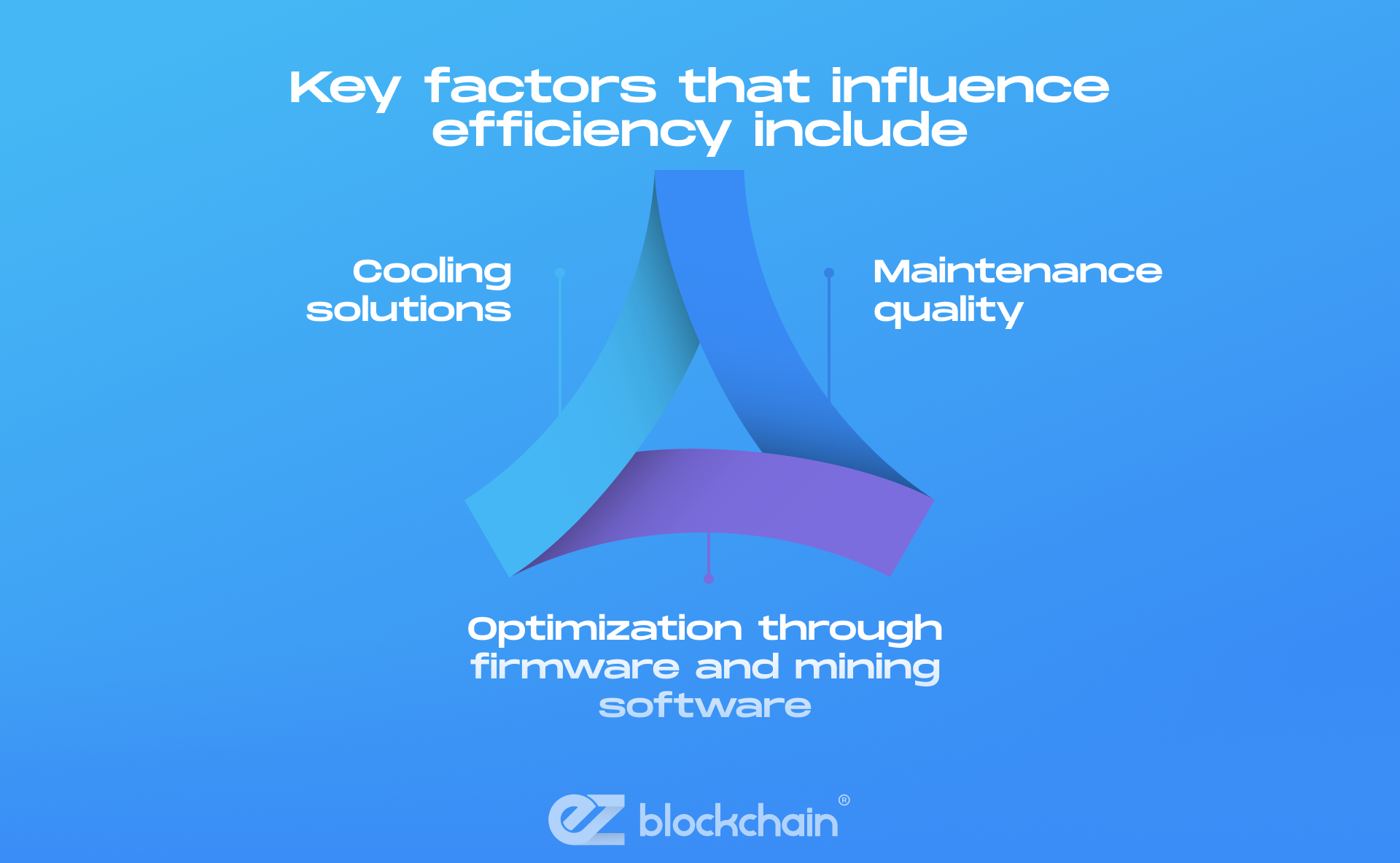Stay up to date with the latest news, announcements, and articles.
- The Role of ASICs in Bitcoin Mining
- Why ASICs Outperform Traditional Mining Hardware
- The Evolution of Bitcoin Mining Hardware
- Efficiency: How ASICs Revolutionize Bitcoin Mining
- Profitability: Maximizing Returns with ASIC Mining
- Market Insights: Trends and Innovations in ASIC Technology
- Challenges in the ASIC Mining Industry
- Monitoring ASIC Performance: The EZ Blockchain Dashboard
- Future Outlook for Bitcoin Mining ASICs
- The Significance of ASICs in Bitcoin Mining
- Conclusion
The rise of ASICs has significantly impacted the Bitcoin mining landscape. These devices have drastically reduced the time and energy required to mine a block, leading to a substantial increase in the overall hash rate of the Bitcoin network. For instance, early ASIC models operated at speeds of around 68 joules per terahash (J/TH), while modern devices achieve efficiencies as low as 21.5 J/TH . This leap in efficiency has made mining more accessible to large-scale operations, often requiring substantial capital investment.
As a result, the mining industry has become increasingly centralized, with a few entities controlling a significant portion of the network’s hash rate . In this article, we will delve into the role of mining ASIC profitability in the Bitcoin framework, examining their efficiency, profitability, industry challenges, and the future of mining hardware.
The Role of ASICs in Bitcoin Mining
ASICs serve as specialized hardware optimized for Bitcoin’s SHA-256 algorithm. Their primary advantages are efficiency and hashrate superiority, making them indispensable for professional mining setups.
- Purpose: To deliver the highest possible hashrate at the lowest power consumption.
- Setup: ASICs are typically deployed in mining rigs housed within large-scale data centers.
- Contribution: They ensure Bitcoin’s blockchain remains secure and decentralized by contributing substantial computing power.
In short, ASICs are no longer optional; they are central to Bitcoin’s survival and growth.

Why ASICs Outperform Traditional Mining Hardware
Early miners used CPUs and later GPUs to secure Bitcoin. However, ASICs outperform these alternatives due to:
- Higher Hashrate – ASICs produce significantly greater cryptographic calculations per second.
- Lower Power Usage – Energy efficiency is drastically improved compared to GPUs.
- Specialized Design – ASICs are tailored exclusively for SHA-256, eliminating unnecessary hardware functions.
- Long-Term ROI – Higher upfront costs are offset by sustained best ASIC profitability.
“ASICs are the backbone of industrial-scale Bitcoin mining, designed for efficiency
and maximizing ROI in an increasingly competitive environment.”
ASICs are the backbone of industrial-scale Bitcoin mining, designed for efficiency and maximizing ROI in an increasingly competitive environment. These specialized devices are purpose-built to execute the cryptographic hashing algorithms required for Bitcoin mining, offering unparalleled speed and energy efficiency compared to general-purpose hardware like CPUs and GPUs. For instance, top-performing Bitcoin ASICs can achieve hash rates exceeding 400 terahashes per second, significantly outpacing GPUs, which typically reach around 120 megahashes per second.
According to a report by Cambridge Digital Mining, the Bitcoin ASIC market is highly oligopolistic, dominated by a single manufacturer holding the vast majority of the market . Such centralization underscores the critical role of ASICs in sustaining competitive advantage and ensuring long-term returns on investment in the Bitcoin mining industry.
The Evolution of Bitcoin Mining Hardware
Bitcoin mining hardware has gone through several technological phases:
- CPU Mining – 2009: Early adopters mined Bitcoin using personal computers.
- GPU Mining – 2010–2011: Graphics cards offered better parallel computation.
- FPGA Mining – 2011–2012: Field Programmable Gate Arrays improved efficiency.
- ASIC Mining – 2013–Present: ASICs became the dominant solution, offering unmatched performance.
This rapid evolution highlights how increasing network difficulty drove innovation, making less efficient hardware obsolete.

Efficiency: How ASICs Revolutionize Bitcoin Mining
The efficiency of an ASIC miner is defined by the ratio of hashrate to power consumption. Modern ASICs achieve:
- Hashrates exceeding 100 TH/s.
- Power consumption of around 3,000 watts.
- Energy efficiency of 25–30 joules per terahash (J/TH).
Key factors that influence efficiency include:
- Cooling solutions (air vs. immersion cooling).
- Maintenance quality.
- Optimization through firmware and mining software.
Efficient ASICs reduce electricity costs, which are the largest recurring expense for miners.
Profitability: Maximizing Returns with ASIC Mining
Profitability in ASIC mining depends on:
- Hashrate Output – Higher hashrate increases chances of solving blocks.
- Electricity Cost – Lower electricity prices directly improve profit margins.
- Bitcoin Price – Revenue is heavily tied to market volatility.
- Mining Difficulty – Regular adjustments affect overall block rewards.
- Setup and Maintenance – Proper installation and optimization reduce downtime.
Tools like the ASIC mining profitability calculator allow miners to estimate ROI by inputting hardware efficiency, local electricity costs, and network difficulty.
“Using an ASIC profit calculator, miners can predict ROI scenarios based on
real-time data, helping them optimize investments.”
The ability to simulate various scenarios is crucial in the volatile world of cryptocurrency mining. By adjusting factors like network difficulty and Bitcoin’s market value, miners can assess potential returns under different conditions. This proactive crypto ASIC profitability approach aids in making informed decisions regarding hardware investments and operational strategies, ultimately enhancing the likelihood of achieving a positive return on investment.
Market Insights: Trends and Innovations in ASIC Technology
The ASIC market is continuously evolving:
- Immersion Cooling: Increasing adoption improves efficiency and hardware lifespan.
- Chip Innovations: 5nm and 3nm chip technology promises even higher hashrates with reduced energy consumption.
- Global Distribution: Production remains concentrated in Asia, but global supply chains are diversifying.
- Corporate Mining: Publicly traded companies now dominate large-scale mining operations.
These innovations aim to maintain competitiveness as mining difficulty rises.
Challenges in the ASIC Mining Industry
While ASICs deliver unmatched efficiency, challenges remain:
- High Initial Investment – Units can cost several thousand dollars.
- Electricity Dependence – Profitability is extremely sensitive to local energy costs.
- Heat and Noise – ASIC rigs generate substantial heat requiring robust cooling systems.
- Regulatory Uncertainty – Government policies on mining vary globally.
- Obsolescence – Rapid hardware evolution makes older ASICs unprofitable within years.
Thus, ASIC mining requires careful risk assessment before investment.
Monitoring ASIC Performance: The EZ Blockchain Dashboard
To optimize ASIC mining profitability, monitoring performance is critical. Tools such as the EZ Blockchain Hardware Dashboard allow users to:
- Track hashrate and efficiency in real time.
- Monitor electricity consumption.
- Identify overheating or cooling issues.
- Automate alerts for downtime or inefficiencies.
- Calculate ASIC profit using built-in calculators.
Such dashboards help miners maximize uptime, reduce maintenance costs, and improve ROI.

Future Outlook for Bitcoin Mining ASICs
The future of ASIC mining will likely see:
- More Energy-Efficient Designs – Leveraging advanced semiconductor manufacturing.
- Increased Decentralization – Wider distribution of hardware among miners.
- Integration with Renewable Energy – Partnerships between miners and green energy providers.
- AI Optimization – Smart software managing hardware allocation and cooling.
The ASIC industry will remain central to sustaining Bitcoin’s blockchain as mining difficulty increases.
The Significance of ASICs in Bitcoin Mining
ASICs represent the pinnacle of mining hardware evolution, providing the power, efficiency, and reliability needed to maintain Bitcoin’s decentralized ledger. They transform mining from a hobbyist pursuit into a large-scale industrial practice. While challenges like regulation, obsolescence, and electricity dependence remain, ASICs continue to deliver the best BTC ASIC profitability opportunities for serious investors.
| Factor | Impact on Profitability | Optimization Strategy |
| Hashrate | Higher hashrate increases mining rewards | Invest in top-ranked ASIC hardware |
| Electricity Cost | Major ongoing expense affecting ROI | Locate rigs in regions with cheap energy |
| Cooling | Poor cooling reduces hardware lifespan and efficiency | Use immersion cooling or advanced ventilation |
| Maintenance | Breakdowns reduce uptime and ROI | Implement proactive monitoring systems |
| Difficulty | Rising difficulty reduces profitability over time | Upgrade ASICs regularly |
| Bitcoin Price | Directly determines mining revenue | Hedge with financial instruments |
This table highlights how ASICs influence every aspect of Bitcoin mining profitability. From hashrate and electricity costs to cooling, maintenance, network difficulty, and Bitcoin price, each factor plays a critical role in determining returns.
By strategically optimizing these variables—selecting high-performance hardware, minimizing operational costs, and regularly upgrading equipment—miners can maximize efficiency and maintain competitiveness in an increasingly industrialized and challenging mining landscape. ASICs remain central to sustaining both the technical integrity and economic viability of large-scale Bitcoin mining operations.
Conclusion
ASICs have fundamentally reshaped Bitcoin mining by optimizing efficiency, maximizing profitability, and driving industrial-scale operations. However, miners must balance high investment costs, maintenance, and regulatory challenges with potential returns. Tools like profitability calculators and real-time dashboards allow miners to calculate Bitcoin ASIC profitability and optimize operations. As technology progresses, ASICs will continue to define the mining landscape, reinforcing Bitcoin’s security while offering profitable opportunities to those who adapt and calculate ASIC profitability effectively.
Fill out a form and our bitcoin mining expert will contact you.
FREE CONSULTATIONchoose
a miner
profit and
understand data?
business remotely
with EZ Blockchain?
Fill out a form and our bitcoin mining expert will contact you.









